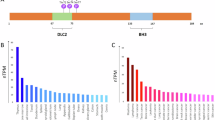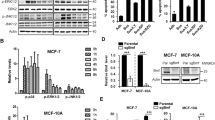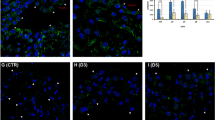Abstract
Tight transcriptional regulation, alternative splicing and/or post-translational modifications of BH3-only proteins fine-tune their proapoptotic function. In this study, we characterize the gene locus of the BH3-only protein Bmf (Bcl-2-modifying factor) and describe the generation of two major isoforms from a common transcript in which initiation of protein synthesis involves leucine-coding CUG. BmfCUG and the originally described isoform, Bmf-short, display comparable binding affinities to prosurvival Bcl-2 family members, localize preferentially to the outer mitochondrial membrane and induce rapid Bcl-2-blockable apoptosis. Notably, endogenous Bmf expression is induced on forms of cell stress known to cause repression of the CAP-dependent translation machinery such as serum deprivation, hypoxia, inhibition of the PI3K/AKT pathway or mTOR, as well as direct pharmacological inhibition of the eukaryotic translation initiation factor eIF-4E. Knock down or deletion of Bmf reduces apoptosis under some of these conditions, demonstrating that Bmf can act as a sentinel for stress-impaired CAP-dependent protein translation machinery.
Similar content being viewed by others
Log in or create a free account to read this content
Gain free access to this article, as well as selected content from this journal and more on nature.com
or
Abbreviations
- Bmf:
-
Bcl-2-modifying factor
- BH:
-
Bcl-2 homology domain
- IVT:
-
in vitro transcription
- IVTT:
-
in vitro transcription and translation
- TSS:
-
transcription start site
- IRES:
-
intra-ribosomal entry site
- FF:
-
Firefly
- RN:
-
Renilla
- ECFP:
-
enhanced cyan fluorescent protein
- SV:
-
Simian virus
- MEF:
-
mouse embryonic fibroblast
- sh:
-
short hairpin
- ORF:
-
open reading frame
- eIF:
-
eukaryotic initiation factor
- DLC:
-
dynein light chain
References
Giam M, Huang DC, Bouillet P . BH3-only proteins and their roles in programmed cell death. Oncogene 2008; 27 (Suppl 1): S128–S136.
Jeffers JR, Parganas E, Lee Y, Yang C, Wang J, Brennan J et al. Puma is an essential mediator of p53-dependent and -independent apoptotic pathways. Cancer Cell 2003; 4: 321–328.
Villunger A, Michalak EM, Coultas L, Mullauer F, Bock G, Ausserlechner MJ et al. p53- and drug-induced apoptotic responses mediated by BH3-only proteins puma and noxa. Science 2003; 302: 1036–1038.
Jost PJ, Grabow S, Gray D, McKenzie MD, Nachbur U, Huang DC et al. XIAP discriminates between type I and type II FAS-induced apoptosis. Nature 2009; 460: 1035–1039.
Yin X-M, Wang K, Gross A, Zhao Y, Zinkel S, Klocke B et al. Bid-deficient mice are resistant to Fas-induced hepatocellular apoptosis. Nature 1999; 400: 886–891.
Bouillet P, Purton JF, Godfrey DI, Zhang L-C, Coultas L, Puthalakath H et al. BH3-only Bcl-2 family member Bim is required for apoptosis of autoreactive thymocytes. Nature 2002; 415: 922–926.
Egle A, Harris AW, Bouillet P, Cory S . Bim is a suppressor of Myc-induced mouse B cell leukemia. PNAS 2004; 101: 6164–6169.
Pinon JD, Labi V, Egle A, Villunger A . Bim and Bmf in tissue homeostasis and malignant disease. Oncogene 2008; 27 (Suppl 1): S41–S52.
Puthalakath H, Strasser A, Huang DCS . Rapid selection against truncation mutants in yeast reverse two-hybrid screens. BioTechniques 2001; 30: 984–988.
Labi V, Erlacher M, Kiessling S, Manzl C, Frenzel A, O’Reilly L et al. Loss of the BH3-only protein Bmf impairs B cell homeostasis and accelerates gamma irradiation-induced thymic lymphoma development. J Exp Med 2008; 205: 641–655.
Villunger A, Scott C, Bouillet P, Strasser A . Essential role for the BH3-only protein Bim but redundant roles for Bax, Bcl-2, and Bcl-w in the control of granulocyte survival. Blood 2003; 101: 2393–2400.
Morales AA, Olsson A, Celsing F, Osterborg A, Jondal M, Osorio LM . Expression and transcriptional regulation of functionally distinct Bmf isoforms in B-chronic lymphocytic leukemia cells. Leukemia 2004; 18: 41–47.
Frenzel A, Labi V, Chmelewskij W, Ploner C, Geley S, Fiegl H et al. Suppression of B-cell lymphomagenesis by the BH3-only proteins Bmf and Bad. Blood 2010; 115: 995–1005.
Hitomi J, Christofferson DE, Ng A, Yao J, Degterev A, Xavier RJ et al. Identification of a molecular signaling network that regulates a cellular necrotic cell death pathway. Cell 2008; 135: 1311–1323.
Puthalakath H, Villunger A, O’Reilly LA, Beaumont JG, Coultas L, Cheney RE et al. Bmf: a pro-apoptotic BH3-only protein regulated by interaction with the myosin V actin motor complex, activated by anoikis. Science 2001; 293: 1829–1832.
Mackus WJ, Kater AP, Grummels A, Evers LM, Hooijbrink B, Kramer MH et al. Chronic lymphocytic leukemia cells display p53-dependent drug-induced Puma upregulation. Leukemia 2005; 19: 427–434.
Ploner C, Rainer J, Niederegger H, Eduardoff M, Villunger A, Geley S et al. The BCL2 rheostat in glucocorticoid-induced apoptosis of acute lymphoblastic leukemia. Leukemia 2008; 22: 370–377.
Weber A, Paschen SA, Heger K, Wilfling F, Frankenberg T, Bauerschmitt H et al. BimS-induced apoptosis requires mitochondrial localization but not interaction with anti-apoptotic Bcl-2 proteins. J Cell Biol 2007; 177: 625–636.
Touriol C, Bornes S, Bonnal S, Audigier S, Prats H, Prats AC et al. Generation of protein isoform diversity by alternative initiation of translation at non-AUG codons. Biol Cell 2003; 95: 169–178.
Kullmann M, Gopfert U, Siewe B, Hengst L . ELAV/Hu proteins inhibit p27 translation via an IRES element in the p27 5′UTR. Genes Dev 2002; 16: 3087–3099.
Spriggs KA, Stoneley M, Bushell M, Willis AE . Re-programming of translation following cell stress allows IRES-mediated translation to predominate. Biol Cell 2008; 100: 27–38.
Wang X, Proud CG . The mTOR pathway in the control of protein synthesis. Physiology 2006; 21: 362–369.
Moerke NJ, Aktas H, Chen H, Cantel S, Reibarkh MY, Fahmy A et al. Small-molecule inhibition of the interaction between the translation initiation factors eIF4E and eIF4G. Cell 2007; 128: 257–267.
Bahl K, Kim SK, Calcagno C, Ghersi D, Puzone R, Celada F et al. IFN-induced attrition of CD8 T cells in the presence or absence of cognate antigen during the early stages of viral infections. J Immunol 2006; 176: 4284–4295.
Nakano K, Vousden KH . PUMA, a novel proapoptotic gene, is induced by p53. Mol Cell 2001; 7: 683–694.
O’Connor L, Strasser A, O’Reilly LA, Hausmann G, Adams JM, Cory S et al. Bim: a novel member of the Bcl-2 family that promotes apoptosis. EMBO J 1998; 17: 384–395.
Chen L, Willis SN, Wei A, Smith BJ, Fletcher JI, Hinds MG et al. Differential targeting of prosurvival Bcl-2 proteins by their BH3-only ligands allows complementary apoptotic function. Mol Cell 2005; 17: 393–403.
Ranger AM, Zha J, Harada H, Datta SR, Danial NN, Gilmore AP et al. Bad-deficient mice develop diffuse large B cell lymphoma. PNAS 2003; 100: 9324–9329.
Graber TE, Holcik M . Cap-independent regulation of gene expression in apoptosis. Mol Biosyst 2007; 3: 825–834.
Kozak M . A second look at cellular mRNA sequences said to function as internal ribosome entry sites. Nucleic Acids Res 2005; 33: 6593–6602.
Baranick BT, Lemp NA, Nagashima J, Hiraoka K, Kasahara N, Logg CR . Splicing mediates the activity of four putative cellular internal ribosome entry sites. PNAS 2008; 105: 4733–4738.
Saffran HA, Smiley JR . The XIAP IRES activates 3′ cistron expression by inducing production of monocistronic mRNA in the {beta}gal/CAT bicistronic reporter system. RNA 2009; 15: 1980–1985.
Ogilvy S, Metcalf D, Print CG, Bath ML, Harris AW, Adams JM . Constitutive bcl-2 expression throughout the hematopoietic compartment affects multiple lineages and enhances progenitor cell survival. PNAS 1999; 96: 14943–14948.
Acknowledgements
We thank Professors A Strasser, C Borner, M Schuler and W Doppler for cells and reagents; S Kiessling and F Müllauer for first experiments initiating this work; W Chmelewskij for help with MEF experiments; B Tomaselli for help with hypoxia experiments; Irene Gaggl for expert technical assistance, as well as all our colleagues in the lab for insightful discussions. This work was supported by grants from the AICR, St. Andrews, UK (no. 06-0440), the Graduate School for Molecular Biology and Oncology (MCBO) and the SFB021, both funded by the Austrian Science Fund (FWF).
Author information
Authors and Affiliations
Corresponding author
Ethics declarations
Competing interests
The authors declare no conflict of interest.
Additional information
Supplementary Information accompanies the paper on Cell Death and Differentiation website
Supplementary information
Rights and permissions
About this article
Cite this article
Grespi, F., Soratroi, C., Krumschnabel, G. et al. BH3-only protein Bmf mediates apoptosis upon inhibition of CAP-dependent protein synthesis. Cell Death Differ 17, 1672–1683 (2010). https://doi.org/10.1038/cdd.2010.97
Received:
Revised:
Accepted:
Published:
Issue date:
DOI: https://doi.org/10.1038/cdd.2010.97
Keywords
This article is cited by
-
Chronic spindle assembly checkpoint activation causes myelosuppression and gastrointestinal atrophy
EMBO Reports (2024)
-
Mild heat treatment in vitro potentiates human adipose stem cells: delayed aging and improved quality for long term culture
Biomaterials Research (2023)
-
The tumor suppressor MIR139 is silenced by POLR2M to promote AML oncogenesis
Leukemia (2022)
-
Dynein light chain binding determines complex formation and posttranslational stability of the Bcl-2 family members Bmf and Bim
Cell Death & Differentiation (2020)
-
Noxa/HSP27 complex delays degradation of ubiquitylated IkBα in airway epithelial cells to reduce pulmonary inflammation
Mucosal Immunology (2018)



